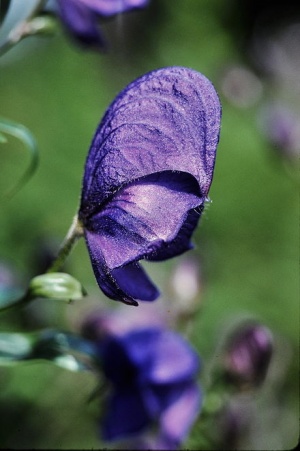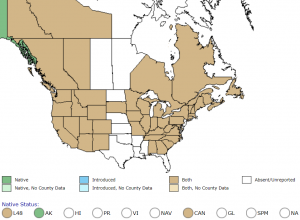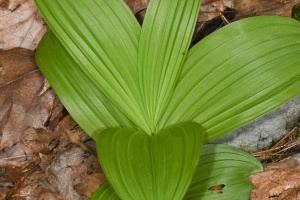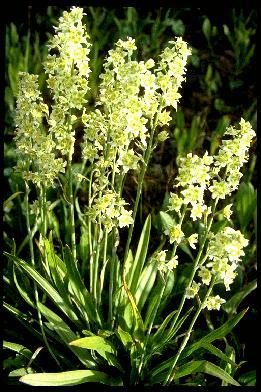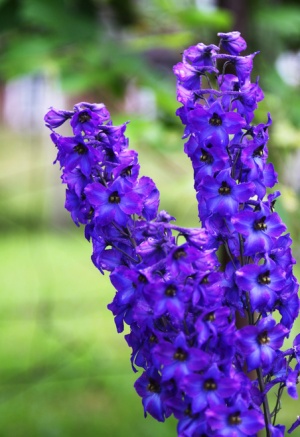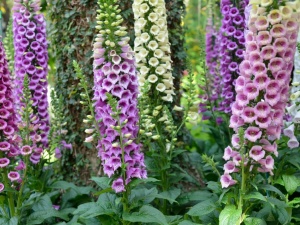Aconitum toxicity
Background
Aconitum spp is a genus of over 250 flowering plants including Monkshood, Wolf's bane, Aconite, Leopard's bane, mousebane, blue rocket, and queen of poisons. In the United States, most poisonous flower ingestions are accidental ingestions by children and account for roughly 2% of all toxic exposures; aconitum is not a commonly ingested flower in the United States, though is responsible for significant morbidity and mortality worldwide. Traditionally, most cases of adult ingestion of toxic flowers that lead to significant symptoms are suicidal attempts. A recent increase in aconitum poisoning has been reported secondary to an increase in available herbal medications utilizing the plant. All parts of Aconitum are toxic, with the roots being most toxic. Toxicity is due to Aconite alkaloids bind to open voltage-gated sodium channels, producing a hyperpolarized state, with permanent activation of the channels. Most herbal preparations undergo decoction process where plant is boiled to hydrolize alkaloids.
Clinical Features
- Estimated lethal dose of wild plant is 1g
- Symptom onset typically between 3 minutes and 6 hours after ingestion with gradual progression of severity
- Nonspecific GI symptoms
- Nausea, vomiting, diarrhea
- Neurotoxicity toxicity
- Dizziness
- Perioral paresthesia
- Visual impairment
- Ataxia
- Paralysis
- Seizures
- Coma
- Cardiotoxicity
- May present with chest pain, palpitations, and syncope
- Hypotension
- Bradycardia
- Most common cause of mortality are arrhythmias which include heart block, ectopic beats, supraventricular tachycardia, bundle branch block, junctional escape rhythms, ventricular tachycardia, bifascicular ventricular tachycardia, polymorphic ventricular tachycardia, torsades de pointes, ventricular fibrillation, and asystole
- Cardiotoxic effects are often persistent and recurrent due to delayed clearance of toxic alkaloids
- Respiratory Toxicity
- Respiratory muscle paralysis often necessitates intubation or leads to death
Differential Diagnosis
- Accidental Ingestion vs Suicidal attempt
- Aconitum Poisoning
- Other toxic plant ingestion
- Including plants with similar symptoms and management such as Veratrum spp (American hellebore), Zigadenus spp (Death Camas), and Delphinium spp (Larkspur) the former two of which are often mistakenly ingested due to their similarity to non-toxic, edible plants
- Non-toxic plant ingestion
- Cardiac Glycoside Ingestion
- Including both pharmaceuticals and digitalis (Foxglove), which is similar in appearance to Aconitum
Evaluation
- EKG
- Elevated CPK and troponin levels with or without myocardial infarction may occur
- Hypokalemia often noted
- Acid-base disorder including respiratory acidosis, respiratory alkalosis, and metabolic acidosis common
- Hepatic and renal impairment are common
Management
- GI Symptoms
- Administration of activated charcoal (0.5-1.0 gm/kg up to 50g) within 1 hour
- No prospective studies so recommendations are case dependent
- Avoid in patients actively vomiting or with altered mental status
- Gastric lavage
- Typically not recommended in most toxic ingestions due to risk of aspiration but applicable in plant ingestions because of large volume of organic material ingested
- Osmotic laxatives
- If in austere environment with limited resources and delayed extraction time:
- 0.5 ounces (15mL) Syrup of Ipecac orally with 500mL of water
- Manual induction of vomiting
- Administration of activated charcoal (0.5-1.0 gm/kg up to 50g) within 1 hour
- Cardiotoxic Effects
- Hypotension
- IV fluids
- Vasopressors if hypotension is persistent
- Bradycardia
- Arrthymias
- Monitor patient on telemetry until 24hrs after symptomatic resolution
- Lidocaine, procainamide, flecainide, or amiodarone
- Hypotension
- Neurotoxic Effects
- Seizure activity
- Respiratory Failure
- May require intubation and mechanical ventilation
- Suicidal Ideation
- Obtain detailed history as to why plant was ingested
- If suicidal ideation is suspected, consider psychiatric referral
Disposition
- All patients suspected of aconitum ingestion should be admitted for 48 hours regardless of symptom presence due to sudden onset of severe symptoms
References
- Graeme, Kimberlie A. "Ch. 65 Toxic Plant Ingestions." In Auerbach, Paul S.; Cushing, Tracy A.; Harris, N. Stuart. Auerbach's Wilderness Medicine (7th ed.).Philadelphia: Elsevier, Inc.
- "Poisoning." Forgey, William W. Wilderness Medicine Beyond First Aid (5th ed.). Guilford, Connecticut: The Globe Pequot Press.
- Adami, Francesco; Paganussi, Peter; Perone, Giovanna; Bera, Paola; Braga, Giosue; Concoreggi, Carlo. Recurrent Ventricular Arrhythmia Caused by Ingestion of Aconitum (Monkshood) Flowers. Wilderness & Environmental Medicine (2018); 29(4): 411-416.
- Chisholm, Hugh, ed. (1911). "Aconite" . Encyclopædia Britannica. 1 (11th ed.). Cambridge University Press. pp. 151–152
- USDA National Resources Conservation Services. Plant Profile Aconitum L. Monkshood https://plants.usda.gov/core/profile?symbol=ACONI. Accessed 4/26/2019.




